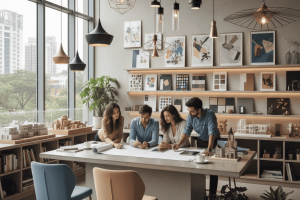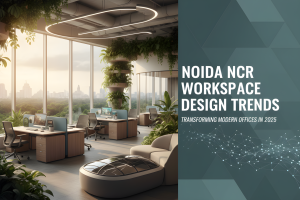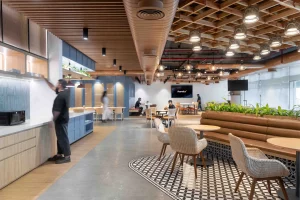Today’s competitive business landscape, organizations are recognizing that their physical workspace is more than just a place for employees to sit and work. Strategic interior design has emerged as a vital tool to boost productivity while simultaneously reinforcing a company’s brand identity.
The workspace environment profoundly influences how employees feel, perform, and interact with the brand, making interior design a strategic priority for forward-thinking companies.
This article explores how well-crafted interior design strategies can transform any workspace into a productivity powerhouse while enhancing brand loyalty and identity.
The Impact of Interior Design on Employee Productivity

Research consistently shows that the design and layout of an office directly affect employee productivity. Strategic arrangement of furniture, lighting, acoustics, and even color schemes positively impacts focus, creativity, and comfort.
Enhanced Focus and Concentration
A well-designed workspace minimizes distractions and supports employees in performing tasks more efficiently. Ergonomic furniture, appropriate lighting, and controlled noise levels help employees maintain focus for longer periods. Studies indicate productivity can increase by up to 15% in environments designed with employee comfort and ergonomics in mind.
Improved Collaboration and Communication
Dynamic office layouts with collaborative zones encourage interaction and teamwork. Flexible seating, open meeting areas, and breakout zones foster spontaneous discussions and innovation. Organizations with flexible work environments report up to a 25% increase in collaborative behaviors, directly correlating with performance gains.
Health and Wellbeing Benefits
Interior design that prioritizes health and wellness, including natural light, greenery, and ventilation, reduces fatigue, stress, and absenteeism. Employees in such environments are more energized, engaged, and satisfied with their jobs, ultimately improving overall productivity.
Reinforcing Brand Identity Through Interior Design

Interior design is also a powerful tool for communicating brand identity. The workspace reflects company culture, values, and mission, shaping both employee experience and external perception.
Creating a Cohesive Brand Experience
When office design mirrors the brand’s personality—whether innovative, traditional, or eco-conscious—employees and clients feel connected to the company ethos. Custom elements such as brand colors, logos, artwork, and design themes strengthen brand recall and unify the physical experience with the corporate mission.
Attracting and Retaining Talent
A thoughtfully designed office environment can attract top talent and increase retention. A workspace that embodies company culture fosters pride, a sense of belonging, and a stronger emotional connection with the organization.
Impressing Clients and Visitors
The office is a first-hand representation of a company’s professionalism and style. A brand-aligned workspace creates lasting impressions, strengthens business relationships, and opens opportunities. An inspiring environment signals attention to detail and reliability.
Implementing Strategic Interior Design: Practical Steps

1. Utilize Data-Driven Insights
Analyze workplace analytics to understand how employees use different areas. Tracking movement patterns, occupancy, and preferences helps design layouts that maximize space efficiency and support diverse workstyles.
2. Prioritize Ergonomics and Comfort
Invest in ergonomic furniture and adjustable workstations that reduce physical strain. Temperature and lighting controls adaptable to employee preferences enhance focus and comfort.
3. Design for Flexibility and Adaptability
Create multi-functional spaces that can evolve with changing needs. Movable partitions, flexible seating arrangements, and modular furniture support hybrid work environments and promote agility.
4. Align Design with Brand and Culture
Incorporate brand colors, materials, and iconography throughout the workspace. Creative design elements reflecting company values and mission strengthen employee engagement and connection.
5. Integrate Nature and Wellness Elements
Use natural light, indoor plants, and air-purification systems to create healthier, productive environments. Wellness rooms and quiet zones provide areas for mental recharge, improving overall morale and performance.
Case Study: Design Studio Transformational Workspace Solutions

At Garage Collective Design Studio, environments are designed to be both visually striking and highly functional, aligned with client brands. By combining workplace strategy, interior architecture, and brand intelligence, Garage Collective creates office spaces that enhance performance and embody organizational values.
Their approach involves detailed research into client needs, analysis of workspace use, and customized design solutions that foster collaboration, well-being, and brand expression. This integration of design and business strategy drives client satisfaction, employee engagement, and measurable productivity improvements.
Conclusion
Strategic interior design is a powerful lever for companies aiming to elevate both employee productivity and brand identity. Thoughtfully designed, brand-aligned environments that prioritize comfort, collaboration, and wellbeing unlock higher performance and employee engagement.
Investing in purposeful design enhances operational efficiency and creates a compelling workspace narrative that attracts talent and impresses clients. As the future of work evolves, the workspace will remain a key differentiator, expertly crafted by studios like Garage Collective to transform organizations and inspire success.
Frequently Asked Questions (FAQs)
Q1. How does interior design affect employee productivity?
Strategic interior design improves focus, comfort, and collaboration through ergonomic furniture, natural light, and well-planned office layouts.
Q2. What design elements strengthen brand identity in offices?
Brand-aligned colors, logos, materials, and artwork embedded in the workspace help employees and visitors connect with company values.
Q3. Why is workspace design important for employee wellbeing?
A healthy environment with natural light, greenery, and wellness zones reduces stress, increases job satisfaction, and enhances productivity.
Q4. How can companies align office design with business goals?
Integrating workplace analytics with brand strategy ensures office design supports employee performance and reflects organizational culture.
Q5. What are key steps to implement strategic interior design?
Use data-driven insights, prioritize ergonomics, create flexible spaces, incorporate brand elements, and integrate wellness features.







